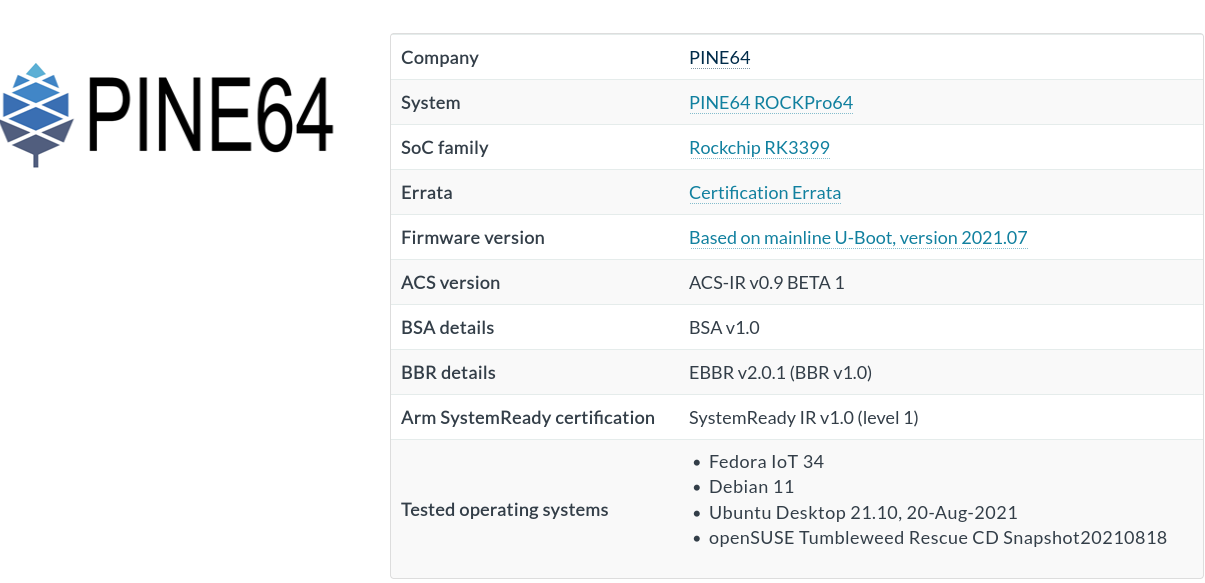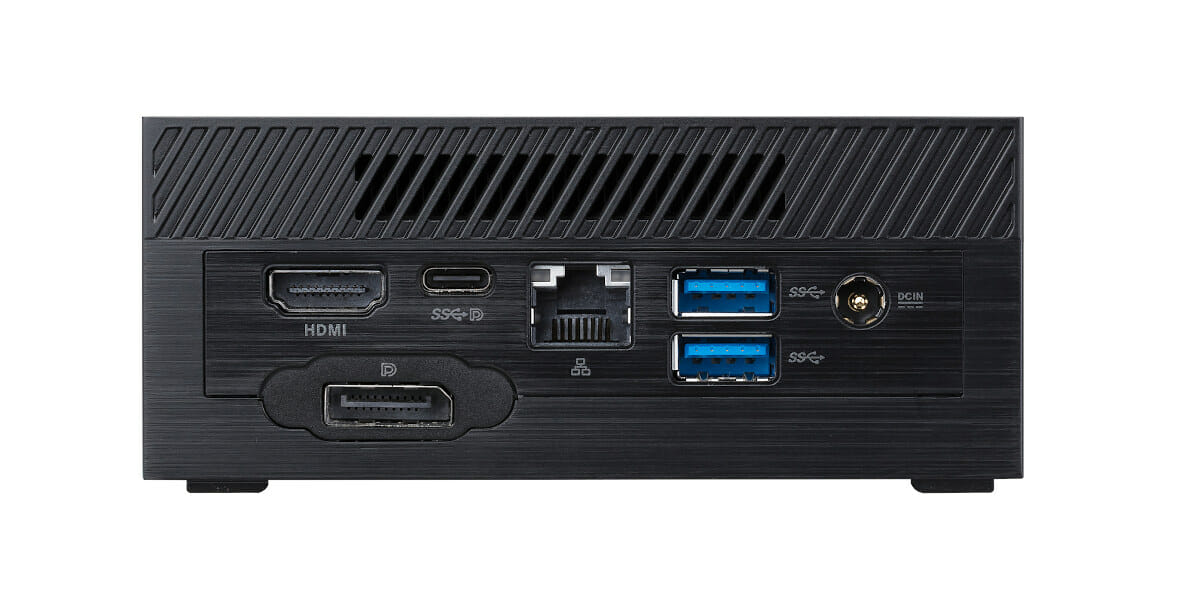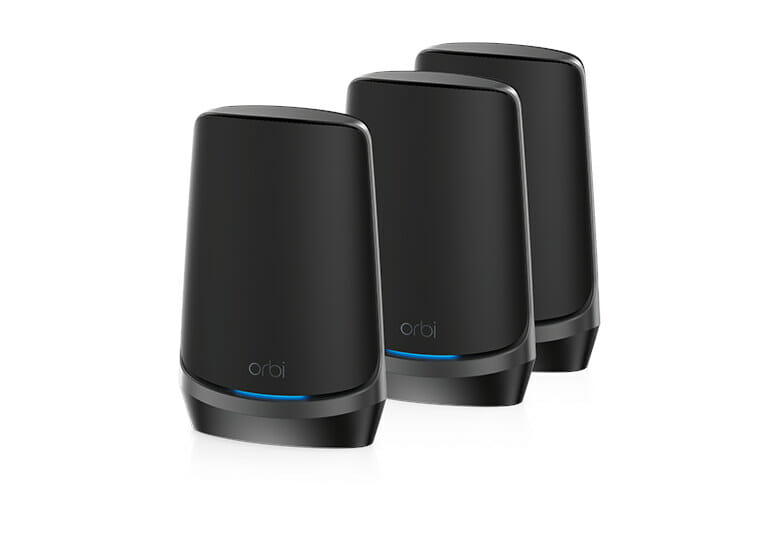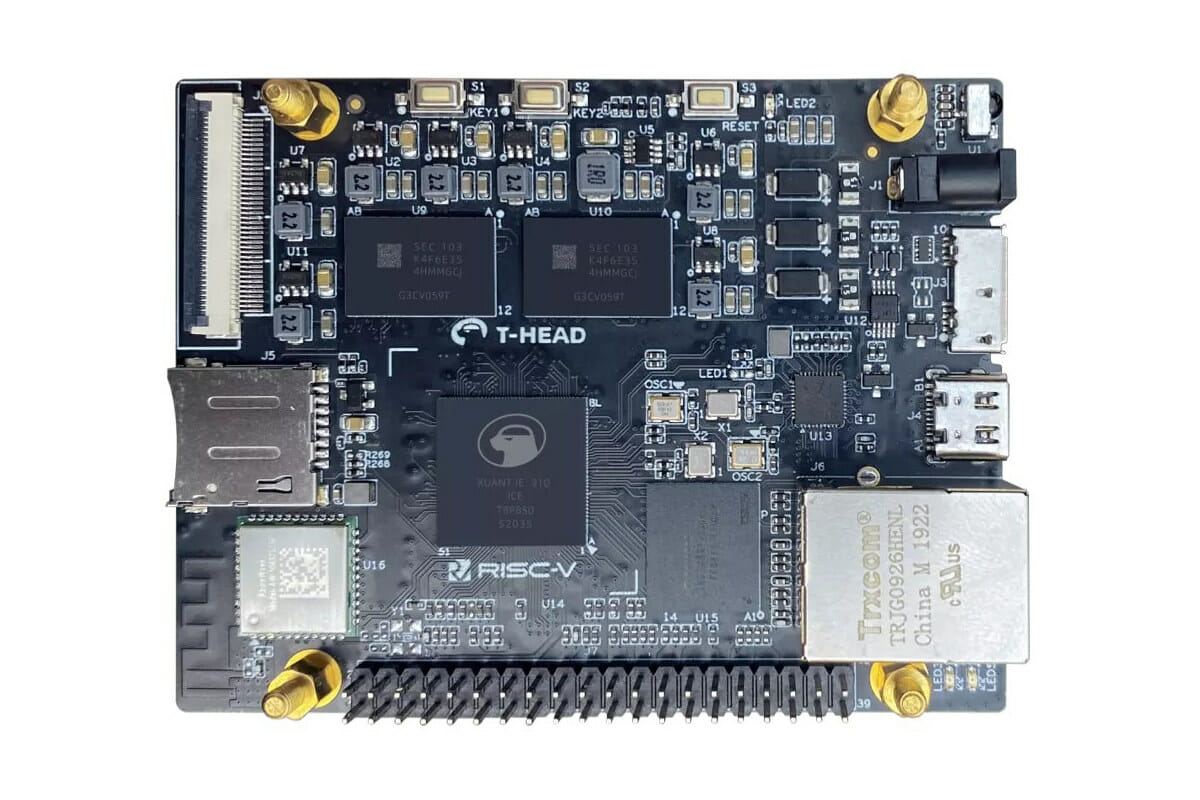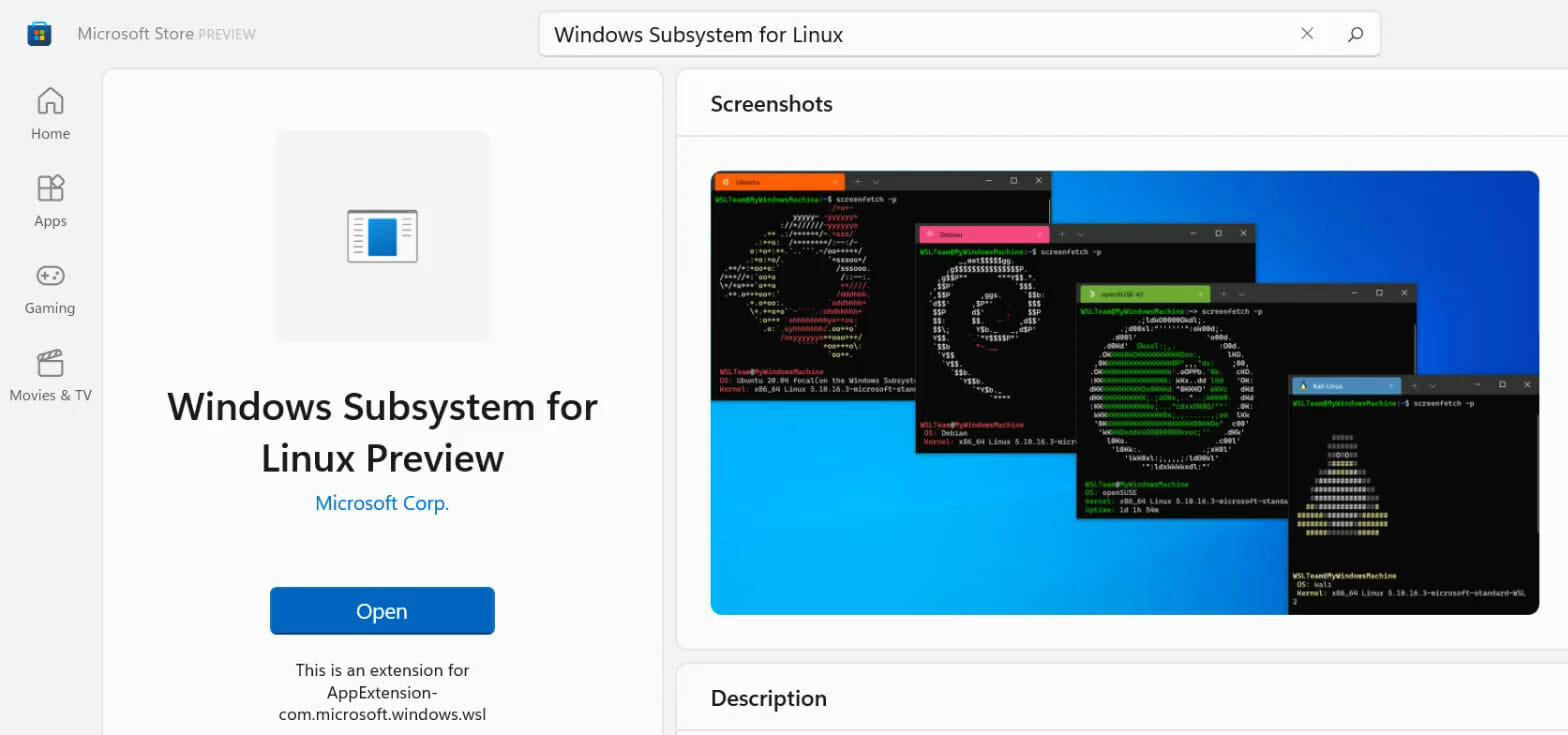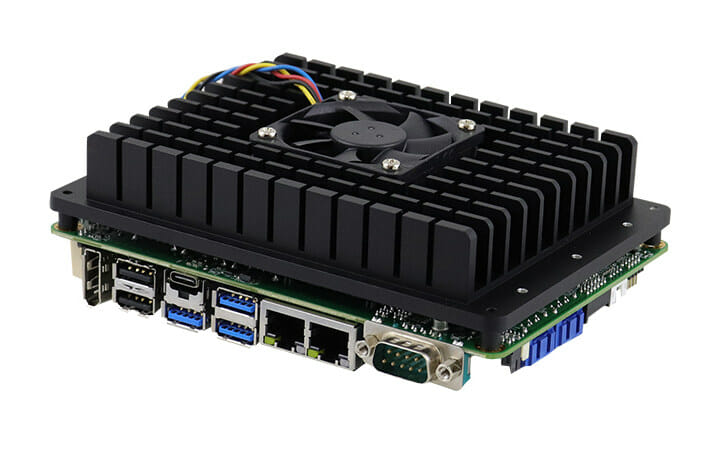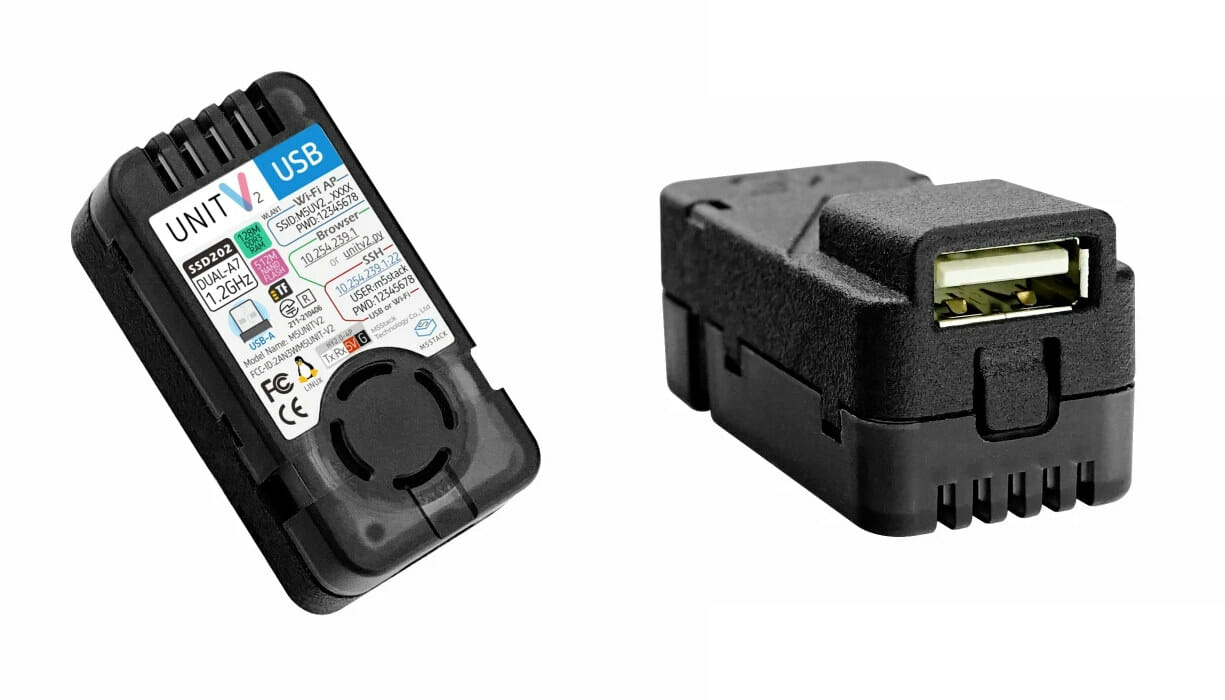The first hardware platforms getting Arm SystemReady IR certification for IoT Edge applications were announced a few months ago with namely NXP i.MX 8 Mini evaluation kit and Compulab IOT-GATE-IMX8 gateway being able to run off-the-shelf operating system images such as Fedora IoT, OpenSuSE Leap 15.3, and Debian 11 thanks to UEFI firmware. But following PinePhone Pro Linux smartphone announcement, and Pine64 October update, we also learned that Rockchip RK3399 based RockPro64 was also Arm SystemReady IR certified, and check Arm’s website directly revealed it was joined by Lenovo Leez P710 “Gateway” SBC, as well as Raspberry Pi 4 and Pi 400 platforms. Let’s check the details and see what off-the-shelf images each board has been tested with. Pine64 RockPro64 RK3399 SBC achieved SystemReady IR v1.0 Level 1 certification meaning it complies with some waivers and workarounds found in the errata document. The board has been successfully tested with Fedora […]
PinePhone Pro Linux smartphone to feature a power-optimized Rockchip RK3399S processor
Pine64 has now announced the PinePhone Pro Linux smartphone with a Rockchip RK3399S hexa-core processor clocked at 1.5 GHz, that’s a power-optimized version of the popular Rockchip RK3399 processor. It will provide a noticeable upgrade to the PinePhone Linux smartphones launched in November 2019, which, by today’s standards, is quite underpowered. Besides the faster processor, PinePhone Pro also comes with 4GB RAM and 128 GB storage which should make it a better candidate at mobile desktop convergence, as well as a 5.95-inch display with 1440×720 resolution, a 13MP rear camera, a 5MP front-facing camera, and more. PinePhone Pro specifications: SoC – Rockchip RK3399S with an hexa-core processor comprised of 2x Cortex-A72 core @ up to 1.5 GHz, 4x Cortex-A53 cores, Arm Mali T860 quad-core GPU @ 500Mhz System Memory – 4GB LPDDR4 @ 800MHz Storage – 128GB eMMC flash storage, MicroSD slot Display – 5.95-inch 1440 x 720 in-cell IPS with […]
ASUS PN41 mini PC offers 2.5GbE networking for $169 and up
When I looked for an SBC or a mini PC with 2.5GbE networking following the discontinuance of ODROID-H2+ SBC, I focused on systems with dual 2.5GbE ports to closely match Hardkernel’s SBC specifications, and most of those systems were rather expensive. But if a single 2.5 GbE port is enough for your application, then there’s a good alternative to ODROID-H2+ with ASUS PN41 mini PC powered by a choice of Jasper Lake processors, and pricing starting at $169 on Amazon for a barebone model with an Intel Celeron N4500 dual-core processor. ASUS PN41 mini PC specifications: Jasper Lake N-Series SoC (one or the other) Pentium Silver N6005 quad-core processor @ 2.0GHz / 3.3GHz (Turbo) with Intel UHD graphics; 10W TDP Celeron N5105 quad-core processor @ 2.0GHz / 2.9GHz with Intel UHD graphics; 10W TDP Celeron N4505 dual-core processor @ 2.0GHz / 2.9GHz with Intel UHD graphics; 10W TDP Pentium Silver […]
NETGEAR RBKE963 Orbi quad-band WiFi 6E mesh system delivers up to 10.8Gbps speed
NETGEAR RBKE963 Orbi quad-band WiFi 6E mesh system delivers wireless connectivity through the home with one router and two satellites with a maximum wireless link of 10.8 Gbps. one 10GbE WAN port for Internet connectivity, and several 2.5GbE and Gigabit Ethernet LAN ports. Powered by a quad-core 2.2GHz processor, the mesh system supports 2.4 GHz, 5.2 GHz, 5.8 GHz, and the new 6 GHz band offered by WiFI 6E, covers an area of up to around 840 square meters, and supports up to 200+ clients. NETGEAR RBKE963’s router and satellites share most of the same specifications: SoC – Unnamed quad-core processor @ 2.2 GHz (likely Qualcomm Networking Pro 1610 Platform) Memory & Storage RBRE960 router – 1 GB RAM, 512MB NAND flash RBSE960 satellites – TBD WiFi connectivity Radio 1: IEEE 802.11b/g/n/ax 2.4GHz with 1024-QAM support up to 1200 Mbps Radio 2: IEEE ® 802.11a/n/ac/ax 5GHz with 1024-QAM support up […]
Alibaba T-head RVB-ICE dual-core RISC-V SBC supports Android 10, Debian 11
The very first RISC-V single board computer with a 3D GPU reveals itself with “Alibaba T-head RVB-ICE” SBC available for pre-order for $399 together with a 7-inch display. The board is based on Alibaba T-Head “ICE” dual-core XuanTie C910 RISC-V processor with a Vivante GC8000UL GPU, and follows the announcement of Android 10 being ported to a RISC-V board earlier this year. Besides the dual-core RISC-V processor clocked at 1.2 GHz, the board is equipped with 4GB LPDDR4, 16GB eMMC flash, and offers Gigabit Ethernet, WiFi and Bluetooth connectivity, as well as a 48-pin GPIO header. But it lacks HDMI output, relying on an LCD interface instead, as well as full-size (Type-A) USB ports with only one micro USB 3.0 OTG port, and a USB-C port for serial console. Alibaba RVB-ICE specifications: SoC – Alibaba T-Head ICE with dual-core XuanTie C910 RISC-V processor @ 1.2 GHz, Vivante GC8000UL GPU, NPU […]
Windows Subsystem for Linux can be installed from the Microsoft store in Windows 11
The Windows Subsystem for Linux (WSL) that offered a Ubuntu Bash on Windows was first introduced in 2016, as more and more developers required a Linux environment within Windows, and Microsoft kept on improving it with, for instance, Windows Subsystem for Linux 2 released in 2019 bringing an actual Linux kernel, improved performance, and Docker support. Until now, WSL was an optional component inside of Windows, requiring you to go to the “Turn Windows Features on or off” dialogue to enable it, and restart your machine. But Microsoft has now announced you can install (a preview of) Windows Subsystem for Linux directly from the Microsoft Store as long as you run Windows 11. The change also means your WSL will be up-to-date as Microsoft pushes new features and bug fixes, and you do not need to modify/update your Windows version to get the latest changes. You’ll still need to go […]
IBASE launches 3.5-inch SBC with AMD Ryzen Embedded V2000 processor
We’ve covered plenty of AMD Ryzen Embedded V2000 SBCs in the past, but it appears IBASE IB952 might be the first 3.5-inch SBC with a Ryzen V2000 processor for the industrial and IoT markets. The board supports up to 64GB RAM, offers two SATA III ports for storage, dual Gigabit Ethernet networking, four display outputs with DisplayPort, eDP and LVDS interfaces, USB and serial ports, as well as expansion through two M.2 sockets. IBASE IB952 specifications: SoC – AMD Ryzen Embedded V2000 with Radeon Vega graphics System Memory – DDR4-2400 SO-DIMM, up to 64GB with ECC support Storage 2x SATA III ports M.2 M-Key socket for NVMe SSD Flash for AMI BIOS Video Output 1x DisplayPort 1.4 port up to 4Kp60 1x DisplayPort 1.2 port via USB-C port up to 4Kp60 1x 24-bit dual-channel LVDS up to 1080p60 1x eDP (embedded DisplayPort) up to 4Kp60 Four independent display support Audio […]
M5Stack UnitV2 AI module gets USB camera and M12 camera versions
M5Stack UnitV2 is an ultra-compact Linux AI camera powered on Sigmastar SSD202D SoC with a dual-core Cortex-A7 processor @ 1.2 GHz, and 128MB on-chip DDR3 that was launched in April 2021 with a Full HD camera featuring a 68° field-of-view. M5Stack has now introduced two new models, one called M5Stack UnitV2 USB without any camera at all, instead relying on an external USB UVC camera, and the other named M5Stack UnitV2 M12 equipped with an M12 socket and shipping with both a normal focal length camera with an 85° FoV and wide-angle focal length with a 150° FoV. M5Stack UnitV2 USB M5Stack Unitv2 USB specifications: SoC – SigmaStar SSD202D dual-core Cortex-A7 processor @ 1.2 GHz with 128MB on-chip DDR3 Storage – 512MB on-chip NAND flash with around 100MB free space, MicroSD card socket Camera – N/A Audio – Built-in microphone Connectivity – 2.4GHz WIFi 4 up to 150 Mbps (RTL8188FTV), […]


